#Naoshima Bath
Text



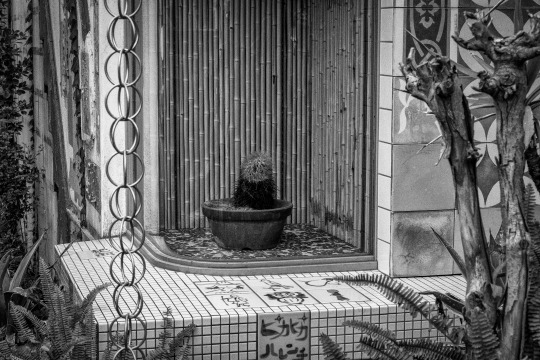
Jumy-M
Naoshima Bath / 直島銭湯 "I♥︎湯"
by artist Shinro Ohtake / 大竹伸朗
108 notes
·
View notes
Photo

📸蔡國強『文化大混浴 直島のためのプロジェクト』/ Cai Guo-Qiang “Cultural Melting Bath: Project for Naoshima” “庭園”とはちょっと異なるけれど、これはランドスケープ…というか枯山水とか環状列石…ストーン・サークルとかそうした目線で見ても面白いのでは…ってことで紹介。 ちなみに #蔡國強 が手掛けたランドスケープとして過去に『いわき回廊美術館』も紹介してます。 . 『地中美術館』や『李禹煥美術館』方面からベネッセハウス・ミュージアムへと向かう途中、砂浜へと向かう斜面を降りたところに現れる『文化大混浴』。 . 東洋と西洋の文化、伝統的なものと現代的なもの…様々な人種や文化が混ざり合う/交差することをコンセプトとするシリーズ。 1998年に設置された後、一時は入浴🛁そのものは休止だったけれど(10年前、憧れて一度だけベネッセハウスに宿泊した時は確か休止中だった)、2020年から《毎週日曜日/ベネッセハウス宿泊者様一組様限定》で入浴体験を再開されたとのこと。 . この眼前に瀬戸内海🌊を眺め見る立地は風水的に直島の中で最も強い気の流れる場所なんだそうで、ジャグジーバスを取り囲む立石は中国の太湖石が配されています。オリエンタルな空間。 . 『ベネッセハウス・ミュージアム』一帯ではその他に大竹伸朗、ジョージ・リッキー等の屋外作品が眺められます。 いずれも瀬戸内海の風景との組合せを意図された作品で、中でも草間彌生さんの“南瓜”🎃が言わずと知れた有名フォトスポット!(今現在は修復中) . 直島・ベネッセ・アートサイト/文化大混浴の紹介は☟ https://oniwa.garden/benesse-house-%e3%83%99%e3%83%8d%e3%83%83%e3%82%bb%e3%83%8f%e3%82%a6%e3%82%b9/ ーーーーーーーー #japanlandscape #japanesegarden #japanesegardens #beautifuljapan #japandesign #jardinjaponais #jardinjapones #japanischergarten #jardimjapones #japanart #landscape #landscapedesign #現代アート #庭園 #日本庭園 #庭院 #庭园 #瀬戸内国際芸術祭 #瀬戸芸 #直島 #naoshima #setouchiart #枯山水 #枯山水庭園 #karesansui #アート #CaiGuoQiang #ランドスケープ #おにわさん (文化大混浴 直島のためのプロジェクト) https://www.instagram.com/p/ChuiZ0lP2A4/?igshid=NGJjMDIxMWI=
#蔡國強#japanlandscape#japanesegarden#japanesegardens#beautifuljapan#japandesign#jardinjaponais#jardinjapones#japanischergarten#jardimjapones#japanart#landscape#landscapedesign#現代アート#庭園#日本庭園#庭院#庭园#瀬戸内国際芸術祭#瀬戸芸#直島#naoshima#setouchiart#枯山水#枯山水庭園#karesansui#アート#caiguoqiang#ランドスケープ#おにわさん
2 notes
·
View notes
Text
naoshima pt. 2
most of us immediately got changed into swimmers and rushed the beach. i collected shells and went on the hunt for crabs. i ended up exploring the rock pools close to the beach, finding a huge amount of critters. while i was doing this my friends in the water were mysteriously attacked but some sort of creature. i of course didn’t see it but apparently it was some sort of big thing that bit their legs resulting in some nasty rashes. i think it could of been an isopod type creature but i’m really not sure. after swimming we ventured off to 7/11, in fact it was the only 7/11 on the island, very different from the main cities where there’s a lawsons, family mart and 7/11 all in the same block haha. i ended up booze cruising on the way back as i couldn’t resist the pull of a 250¥ asahi. dinner was prepared for us by the resort, it was kind of a korean bbq type deal where we cooked our own food on a grill built into the table. this is where we met taka, a member of staff for the dinner service, more on him later. with smoke blowing in our eyes from the grills and bellies full of bbq and beer it was time to turn in. my friends and i ended up drinking by the ocean throughly enjoying ourselves until it was time for bed. i passed out almost immediately so i missed the snoring coming from one of our bunk mates haha. in the morning i got up early and payed 200¥ for a hot shower. i ended up skipping breakfast as my pickiness got the better of me. instead i enjoyed a solo ride around the island. stopping at multiple small shrines along the way. i ended up in the mountains enjoying breathtaking views. i found three sun bathing cats and attempted to befriend them but sadly they didn’t want a bar of me. after costing down the mountains at incredible speed i ended up back at the camp in time for the group excursion to the hiroshi sugimoto gallery. honestly i found the exhibition lovely. it was very much my kind of art, a little brutalist, a little traditional, the works varied from impressively large silver gelatin prints to impressively tiny glass sculptures. the whole gallery it’s self was an art piece honestly, the architecture, lighting, location it was all perfect. after enjoying the artworks we sat in the gallery lounge as our ticket included traditional tea and sweets. the table we were seated at was a huge piece of beautiful wood topped with glass it was almost like a petrified tree stump, i’m not sure but it was gorgeous. i chose to order a matcha which was beautifully vibrant and tasty, the sweet which came with it was fine but i’m not a huge fan of traditional japanese sweets, it sort of just tasted like vaguely sweet raw flour. after leaving the meditative lounge i hit up the gift shop of course just like any good tourist. on the way back to the camp we stopped by the other famous kusama pumpkin and took some obligatory tourist photos. i like yayoi kusama but being honest her art isn’t my favourite so the pumpkin was just so-so for me. after leaving the pumpkin i went to the beach for a smoke and ended up getting distracted by the rock pools. i spent about 40mins investigating each little pool. i began to notice shells mysteriously moving and realised there were tonnes of hermit crabs and sea snails hanging out in the pools. of course i immediately grabbed the biggest hermit crab and put him on my leg waiting for him to gain the confidence to crawl away. thoroughly relaxed i decided to venture to the side of the island that i hadn’t seen however i didn’t realise that this area was part of a fancy resort and bikes were forbidden. of course i’m very lazy and loved my motorised bike so i was heartbroken. i ended up walking through the resort and up the hill to the benesse house gallery, by the time i got there i was red and soaked in sweat, at the ticket desk the attendant politely commented “oh it’s very hot isn’t it” yeah no kidding hahah. honestly the art in this gallery was fine but i was a little disappointed.
0 notes
Photo

9 notes
·
View notes
Text
Love at the first sight with NAOSHIMA!
If you know me for a little longer, you probably know that I love art and museum. This is one of the reasons (from so many reasons) why I love Naoshima even before I stepped on this little island. Naoshima, as a gateway to the Setouchi International Art Triennale that is held every three years, is a mecca of contemporary art. Much of Naoshima’s art was installed by Benesse Corporation. Unfortunately, I was unable to visit the museums there since most of them need pre-order tickets. The artworks are divided into three areas; Miyanoura Port, Honmura Port, and Benesse House Area with a total of 22 artworks.
na01 Red Pumpkin (Yayoi Kusama)

na02 Marine Station “Naoshima” (KAZUYO SEJIMA + RYUE NISHIZAWA / SANAA)

na03 BUNRAKU PUPPET (José de Guimarães)

na04 Naoshima Pavilion (Sou Fujimoto)

na05 Naoshima Bath “I❤湯” (Shinro Ohtake)
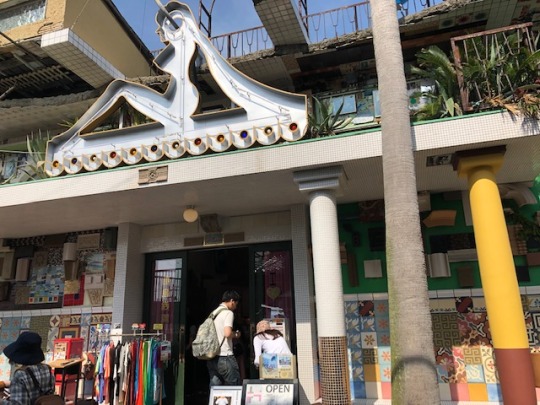
na06-B Miyanoura Gallery 6│Setouchi “ ” Museum

na08 Naoshima Hall (Hiroshi Sambuichi)
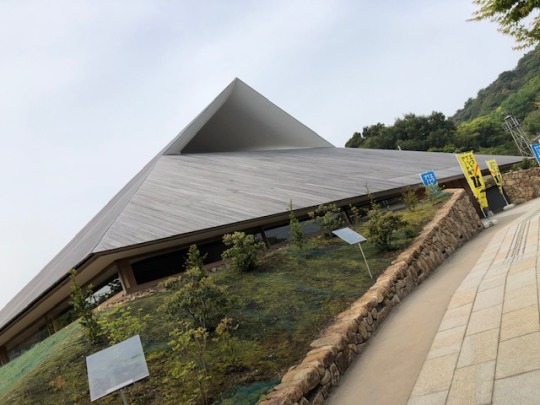
na09 Naoshima Port Terminal (KAZUYO SEJIMA + RYUE NISHIZAWA / SANAA)
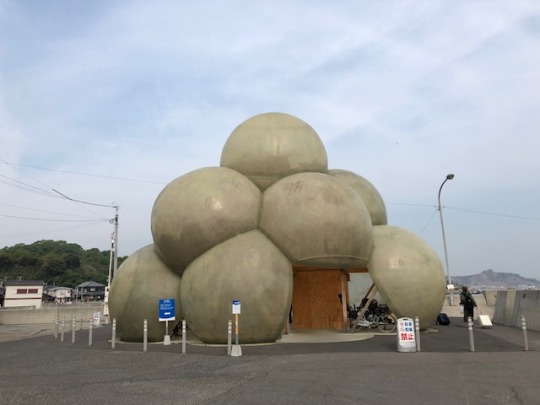
na10 ANDO MUSEUM (Tadao Ando)

na13-B Art House Project “Minamidera” (James Turrell)
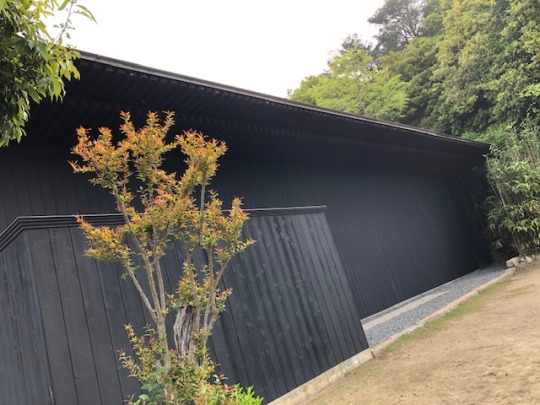
More pic of Naoshima :p



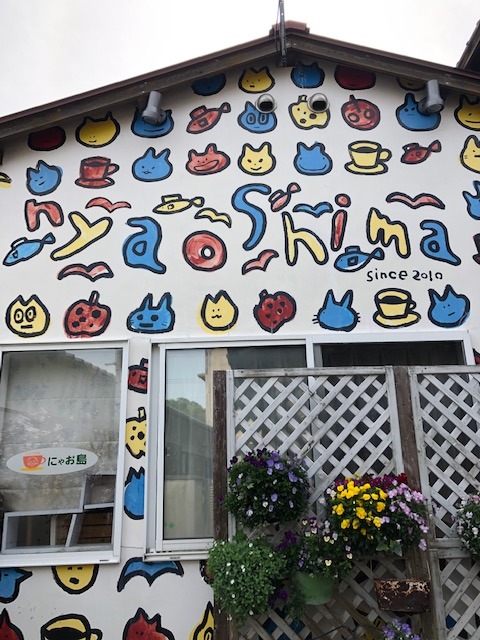

As part of Kagawa Prefecture, which is famous for udon, this trip isn’t complete before trying Kagawa Udon and Naoshima Beer. And the best of the island is Kinosaki udon.

#wanderlust#travelphotography#tourism#trip#vacation#travelgram#traveling#travelers#explore#lovetotravel#solotravel#mytraveldiary#japan#kagawa#naoshima#visitjapan#visitjapanjp#japantravel#visitnaoshima#setouchitriennale#art#artworks#contemporaryart#redpumpkin#yayoikusama#kagawaudon
1 note
·
View note
Photo

Seeking great nature in Shikoku island. It was my third time to go around the island. This time was different thou, because I've experienced camping in a car and island hopping. I had a really nice time staying there. I could feel summer on that small island. --- Kagawa : Naoshima(Yellow Pumpkin and Naoshima Public Bath I Love Yu), Shodoshima, Chichibugahama Beach. Tokushima : Double Vine Bridges, The statue of the Peeing Boy, Mt.Tsurugi. Kochi : Katsurahama(Sakamoto Ryoma Statue), Shikoku Karst. Ehime : Shimonada station. #Japan #Shikoku #Kagawa #Tokushima #Kochi #Ehime #Shodoshima #Naoshima #udonhopping #ohenro #kusamayayoi #tokushimaramen #MtBizan #katsuo #dogoonsen #autocamp #camping #coffeeroaster #summervacation #sunburn #travel #covid19 (at Shikoku) https://www.instagram.com/p/CDGTnrYjyAL314OL4cEpHU9oBEKzGk5sRWiy5g0/?igshid=r35nxximmqgr
#japan#shikoku#kagawa#tokushima#kochi#ehime#shodoshima#naoshima#udonhopping#ohenro#kusamayayoi#tokushimaramen#mtbizan#katsuo#dogoonsen#autocamp#camping#coffeeroaster#summervacation#sunburn#travel#covid19
2 notes
·
View notes
Photo

I❤️ゆ. 🇯🇵 Follow @nipponrama if you know your hiraganas. - This building is a public bath on the island of Naoshima. - #naoshima #travel #onsen #hotspring #urbex #urbanexploration #decay #abandoned_junkies #abandonedbuilding #ruins #picoftheday #urbandecay #abandonedworld #kagawa #instajapan #japangram #shikoku #setoinlandsea #traveljapan #setouchi #instatraveling #instagood #instatravel #travelgram #instapassport #travelingram #mytravelgram #nipponrama #travelblog #hiragana https://www.instagram.com/p/BtqM8_HjEeO/
3 notes
·
View notes
Photo

Naoshima Bath I♥湯 “I LOVE YU” BY Shinro Ohtake
2 notes
·
View notes
Photo

【アートにふれ、直島で過ごすゆったり大人時間 宮ノ浦編①-Naoshima-】 . 島全体がアートで彩られる、アートの島として人気な直島。 インスタ映えする‼️とカメラ女子にも人気。 アートはもちろん、自然や島ならではのゆったりと流れる空気感も魅力の1つ。 . そんな直島の魅力を数回に分けてお伝えします🎶 . ~宮ノ浦エリアの代表的なアート作品①~ . 《直島銭湯 「I♥湯」大竹伸朗》 浴槽に入れ��、全身でアートを感じられる! 実際に入浴できる美術施設。 . 色鮮やかで奇抜な外観はもちろん、内装や、浴槽、風呂絵、モザイク画、トイレの陶器にいたるまで大竹伸朗さんの世界が反映されています。 . . Naoshima is a popular spot where the whole island is decorated with art. It's popular among camera girls, because it's very instagramable. . I will tell you about the Naoshima's charm in several ways🎶 . -Representative art works in the Miyanoura area①- . 《Naoshima bath “I ♥湯” Shinro Ohtake》 If you enter the bathtub, you can feel the art with your whole body! An art facility where you can actually take a bath. . . +・+・+・+・+・+・+・+・+・+ ♕Yumi's Instagram♕ @yumi.tabinotane 日本、世界の旅のたね(travel information)をお届け♪ 旅の思い出投稿は #たびのたね で募集中☺️🎶 +・+・+・+・+・+・+・+・+・+ . #アートの島 #直島 #Naoshima #直島銭湯 #直島銭湯i❤︎湯 #アート巡り #instagramableplace #世界で見つけた色彩 #インスタ映えスポット #おうちで旅気分 . (直島銭湯I♡湯) https://www.instagram.com/p/CAg87UsA9a4/?igshid=1q2hhl3kj9hza
0 notes
Photo

\おにわさん更新情報📸/ [ 香川県直島町 ] ベネッセハウス Benesse House, Naoshima, Kagawa の写真・記事を更新しました。 ーー #安藤忠雄 の設計による『ベネッセアートサイト直島』の中心施設と、その周囲に広がるアート作品🎃が点在するランドスケープ。 ・・・・・・・・ 自分語りwから。庭園の写真を集中的にセレクトしてると、こんなに日本庭園ばかりが好きなのだっけ?と思えてくる。わかりやすく言うと飽きる。笑。 30代で日本庭園1000箇所観に行った、と言うとまあ『庭園ガチオタ』には違いないのだけど、『日本庭園は大人向けの高尚なカルチャーである』ーーという風潮は好きではなくて。 日本庭園付きの豪邸作ったり、日本庭園ある高級旅館に数万円払える大人ならわかる。たかが数百円の入場料・拝観料でわかった気になって上から目線になるのって、キモくないですか。なんかダサい。若者でもライブやフェス、グッズに数千、数万と払うのに。 #マニアがジャンルを潰す という言葉がある。それめちゃくちゃわかる。閉鎖的なカルチャーはシュリンクしていく。 だから……自分は客観的に見たらマニアなんだろうけど、なるべく上から目線感無いように気をつけている。 そんなこと思ってると…別に日本庭園の専門性を突き詰めたいわけじゃないよな、と思えてくるので自分が考えていて楽しい場所もより載せていこうと思った。 …まあこれまでも #瀬戸芸 関連は載せてるけど、何度も足を運んでるこの場所も立派なランドスケープだったなあと。 ーーーーーーーー ベネッセハウスは“現代アートの島”直島でいとなまれている『ベネッセアートサイト直島』の中心施設で、美術館『ベネッセハウス ミュージアム』🏛といくつかの宿泊棟からなり、そして目の前に瀬戸内海🌊をのぞむ屋外の園地(宿泊客以外も散策可能)には現代アート作品が点在しています。 庭園として語られることはそんなに無いけれど、写真の #蔡國強 『文化大混浴 直島のためのプロジェクト』(“Cultural Melting Bath: Project for Naoshima”)の写真を見直した時に、これは #枯山水庭園 とか環状列石とかそうした目線で見て面白い作品なのではと思ったこと、そしてニキ・ド・サンファル作品のあるパーク棟の前の園地も紹介する意味があるランドスケープなのでは、と思ったので紹介! ちなみに蔡國強が手掛けたランドスケープとして『いわき回廊美術館』も紹介してます。 個人的には直島🏝は2019年の瀬戸芸で7回目。2012年の2度目の時にベネッセハウスに泊まったよ!!ひとりで!! その時に記したこのエントリはしばらくのあいだ『ベネッセハウス 一人』でググると最上位に表示され続けたのですが(笑)、最近は下がってきた。その時は真冬だったので手を挙げなかったけど、「文化大混浴」はベネッセハウス宿泊者に限り入浴することが可能(だった。今はできないみたい) 現 福武財団理事長 #福武總一郎 さんの依頼で安藤忠雄により設計されたベネッセハウス。1992年に現在のミュージアム棟が竣工、その後オーバル、2006年にパーク、ビーチという宿泊棟が増築されて現在に至ります。 自分が宿泊したのはパーク棟。部屋にはジェームズ・タレルの絵画があって、そして館内には杉本博司さんの作品がいくつも展示されていた。中でも記憶に残っているのは坪庭『苔の観念』。古い写真だけど記事の方に載せました。 園地一帯では前述のアーティスト以外にも大竹伸朗、ウォルター・デ・マリア(『地中美術館』の展示作家のひとり)等の屋外作品が眺められます。 いずれも瀬戸内海の風景との組合せを意図された作品で、中でも草間彌生さんの“南瓜”が言わずと知れた有名フォトスポット。 行くたびにエネルギーもらえる直島。これからも死ぬまで何度も訪れます! 〜〜〜〜〜〜〜〜 🔗おにわさん記事URL: https://oniwa.garden/benesse-house-%e3%83%99%e3%83%8d%e3%83%83%e3%82%bb%e3%83%8f%e3%82%a6%e3%82%b9/ ーーーーーーーー #庭園 #日本庭園 #garden #japanesegarden #japanesegardens #ランドスケープ #landscape #直島 #直島町 #naoshima #香川 #香川県 #kagawa #瀬戸内国際芸術祭 #artsetouchi #美術館 #artmuseum #museum #枯山水 #karesansui #CaiGuoQiang #おにわさん (Benesse House Art Site Naoshima) https://www.instagram.com/p/B9RNsc5plCB/?igshid=3147ddv60vmr
#安藤忠雄#マニアがジャンルを潰す#瀬戸芸#蔡國強#枯山水庭園#福武總一郎#庭園#日本庭園#garden#japanesegarden#japanesegardens#ランドスケープ#landscape#直島#直島町#naoshima#香川#香川県#kagawa#瀬戸内国際芸術祭#artsetouchi#美術館#artmuseum#museum#枯山水#karesansui#caiguoqiang#おにわさん
0 notes
Photo

ゆ Yu means hot water sign of public bath #naoshima #naoshimaisland #setouchi #setoinlandsea #kagawa #okayama (直島町) https://www.instagram.com/p/B791h2_AA3N/?igshid=531m42y2o4kx
0 notes
Photo
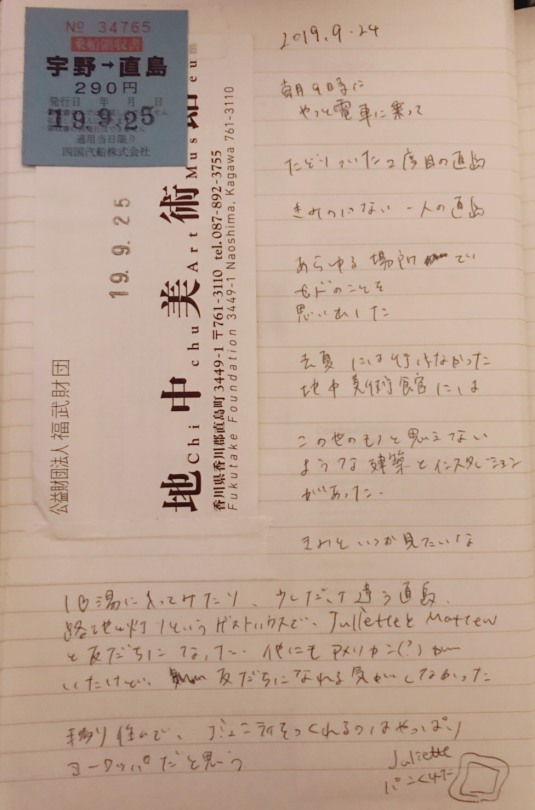
---
24-09-2019
Travel notes from Naoshima trip
---
I got on the train leaving Tokyo at 9.
Now that was the second time of visiting Naoshima,
Naoshima visit by my self without you.
Every place in this island reminded me of you.
Chichu Art Museum that we missed to go last summer,
was a minimalist architecture with artworks inside, which I thought are out of the world.
I hope I can come here again with you.
In evening I took a bath at “I♡湯” (”I♡YU”,Public bath) and stayed at a gueshouse called “路地明” (”Rojiakari”: back alley lights).
I made friend with a French girl called Juliette and a Swiss guy called Mattew at the guesthouse. There were also some Americans but I didn’t feel like that we can be friends.
If I would immigrate and have a community, it’d be somewhere in Europe I think.
(Illustration of bread, “Juliette gave me a toast”)
0 notes
Photo

Come Craft in Japan! Day 37: Tokushima to Awa 35km, 261m climbed We say bye to our new friends from Colliberty guesthouse and rush through the palm lined streets of Tokushima city to Ruafu indigo dyeing studio! Thanks to Sae san who helped us make an appointment. This family run studio is amazing Their Dye is made from indigo leaves dried and fermented for 40 days then mixed with oak ash and lime powder. We Learn that they are also catholic ! so we talk a little about the Pope visiting Japan in a few days and they kindly send us off with tons of candy! We arrive Awa, a lush mountain area and can hear the river in the dark as we descend to the onsen and warm meal at the inn under the bridge. Day 38: Awa to Shionoe 38km, 872 m In the morning we wake up to the clear river from a morning Hotspring bath before we go to Awagamk Paper Factory for another workshop! @mayakyanon ‘s old stomping grounds :) Washi Paper Making is a long time art and the workshops at the factory are accessible to all. They also have aizome (indigo) dyeing station goes 2 meters deep! I would happily submerge myself in that blue black vat. The soft pulpy paper is perfectly formulated with plant fibers from Kozo, mitsumata and gampi plants and a goopy demulcent Neri plant to help suspend the fibers. A VHS teaches us the laborious process of harvestig, processing and crafting this very strong and beautiful paper. You can Even use it for kites! Day 39: Shionoe- Takamatsu- Megijima 26km, 225m, 20 min ferry ride Why do we write all this? Mostly to share our unique days with you but also to share Japan! We got you visit, especially tokushima and the Seto insland sea some day. This is where the famous art islands are like Naoshima. We leave the Tokushima mountains and enter Kagawa prefecture. We get a preview of Takamatsu city before taking a ferry to Megijima island to camp for the night, also known as Onigashihima, island of demons from the Japanese folktale everyone in Japan knows, MomoTaro, a boy born from a peach who goes on a heroic adventure with animal companions. The only creatures we witness by our our pine tree beachside campsite are wild boar and kittie cats. https://www.instagram.com/p/B5w8ToZlwaw/?igshid=15p9klo3pm0pc
0 notes
Text
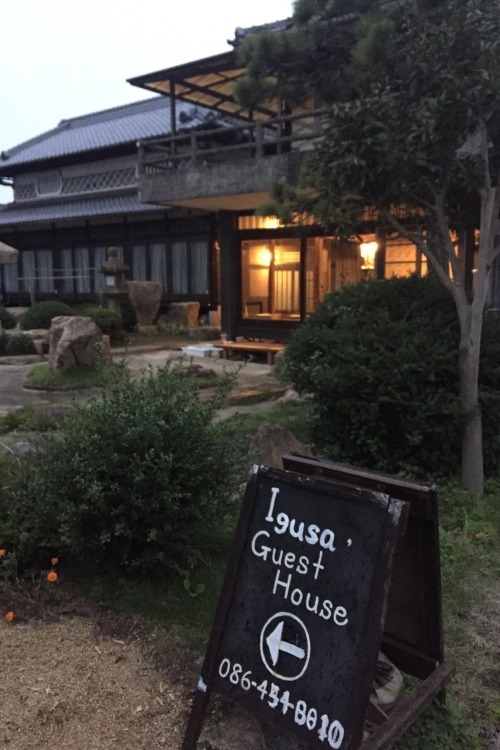
I stayed in Hayashima, Okayama for 5 days at a special place called Igusa Guesthouse. Igusa is the plant that tatami is made of, and the guesthouse used to be a tatami workshop. It was in a residential area, just a short walk from the train station.

Loom to make tatami
Igusa was small, but I met a lot of interesting and friendly people. Staying there was like staying with a multicultural family. The night I arrived I had dinner with 2 couples, from Holland and France. All of the restaurants were closed, so we got food from the supermarket and ate in the kitchen. The French couple was middle-aged with stylish glasses that looked almost like they were upside down. The wife kept turning to me and smiling affectionately. The Dutch couple ate thick slices of buttered toast with salad for dinner. The woman worked at a residency for mentally ill patients in the forest. It has 150 people, and they all work and share life together, like a commune.
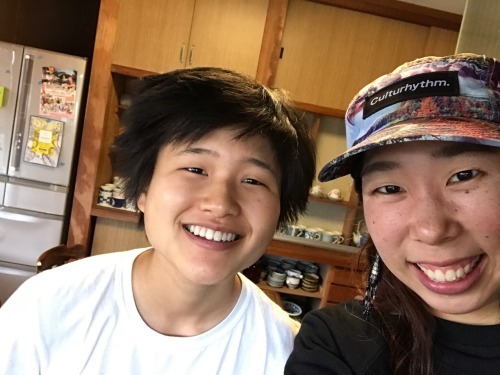
My roommate for one night, K. We had breakfast together and couldn’t speak each other’s languages. She had been backpacking for a few months
The guesthouse workers consisted of Tatski, Ishi, and Takahiro. Tatski and Takahiro were my age, and knew each other from college. Takahiro had just spent two months walking across Japan and sleeping in parks, pulling a handmade cart that folds out to cook on. Igusa was along his route, so he was going to be working there for 3 weeks.

On my first day I went to Kurashiki, a historic city with a canal that runs through it. It was simple and beautiful, and the cloudy weather made it even more so I think. There were many streets of old storehouses converted into shops and eateries, and it was nice and quiet. By far my favorite place I’ve been to as a tourist.
I had some trouble finding the bus stop to get home, and asked a boy leaving the convenience store for help. He was young but with his mannerisms and clothing he was like a small man, with an an ice cream waffle in hand. He asked two different store clerks where the bus stop was, walked me all the way there, and even offered me bus money. People here are so, so kind..

I got back to the guesthouse and we all had nabe (hot pot) to celebrate Takahiro joining Igusa. It was me, the Dutch couple, Ishi, Tatski, Takahiro, and two girls that usually worked in a guesthouse of the same owner in Kurashiki. There was a mix of Japanese, English, and Dutch around the two bubbling pots of soup and sake. Eventually we all managed to have one conversation in English.

On the ferry to Naoshima
The next day I went to Naoshima, also known as art island. It has many art museums, eateries, and charming hostels. It rained the whole time, so maybe it wasn’t as nice of an experience as it could have been. I also kept getting lost. But ah well! It was still pretty cool. I went to Minamidera, one in a series of abandoned houses turned into artworks. It was a minimal wood constructed building on the outside, and inside was complete darkness. Only 15 people could go in at a time, and once inside we felt along the wall and inched our way to a bench where we were told to sit down. Bathed in (almost) silence and blackness, after about 15 minutes our eyes adjusted and we saw a rectangle of very dim light in front of us. It looked like a screen. We walked up to it and found that it was not a screen, but a hole in the wall. You could put your hands out into it but see nothing, just a purple-grey haze. It was quite surreal.
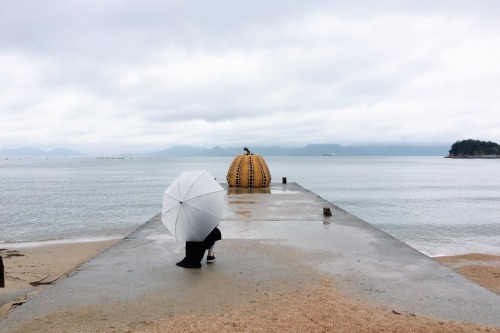
Yayoi Kusama

Waiting for the bus

Cats at a closed café
I booked an extra night because of the typhoon. It poured all day, so I stayed in on my last day. I made a coaster out of igusa and Tatski taught me how to braid it too. I ate dinner with a new French couple, Francoise and Dominique, two retirees that used to be high school teachers in a part of France that many refugees and immigrants come to. They had many Haitian refugees come, who would have outbursts of anger and get into fights everyday. One time a boy came in with a huge knife looking for someone. There was also a lot of voodoo, and they would find chicken heads and feet on the ground. Sometimes kids would come to school and say they couldn’t see, because someone blinded them with voodoo. Woah.
Francoise and Dominique were funny. I could tell they knew each other very well and enjoyed being together. They met in that school and later taught at two other schools, alway sticking together. At one point Francoise made up a word, to which Dominique said, “Francoise is crazy, always making her own language. A life with Francoise is always an adventure!”

I made a lot of miso oatmeal here
The next morning I packed up my things and left for Okayama station. I had to check out at 11am but my bus to my next host was at 5:40pm. So I put my backpack in a locker at the station and wandered around the city till then. I got a bowl of cold udon and it was so, so good.
And finally I took a 3 hour bus to Hiruzen, where I am staying with Eiko san, Jiro san, and their daughter, Kotowa san (9). She is kind of annoying so far. Eiko san is a tiny woman that is always smiling, while Jiro san is completely expressionless. Only Eiko san speaks English, and very basic, so I’m not able to have much conversation with them. I wonder how living with them will be ?
1 note
·
View note
Photo

It’s not an obvious place to come across a piece of art. At an abandoned school, I climb a staircase past ivy-covered storage rooms to a raised outdoor space – and the swimming pool comes into scene-stealing view. The pool, faded starting blocks still in place, has not been used by schoolchildren for over a decade, yet it’s currently brimming with life. Hundreds of wooden boxes line its edges, each neatly packed with fresh flowers and plants, a sense of nurturing reflected in rainbow shades of pink, yellow and purple with hints of rosemary. But most eye-catching of all is the surface of the pool: smooth and glassy in hues of green, with seamless reflections of the forests, rice fields and skies that surround it, creating the sensation of stepping into a vast theatrical tableau of Japanese rural life.
One of Yayoi Kusama’s pumpkins on Naoshima
Forget the minimalist white walls of a modern art gallery in some cosmopolitan hub. This artwork – by Italian Giacomo Zaganelli – is situated somewhere entirely different: Shodoshima, a remote island surrounded by the calm waters of the Seto Inland Sea in Japan. It is just one of 213 artworks scattered across the rice fields, ports, old houses, beaches and vacant schools of 12 islands and two ports for this year’s Setouchi Triennale – the fourth edition since its 2010 launch. The concept, according to its founders, is simple: the event taps into the power of contemporary art to revitalise rural communities hit hard, like so many across Japan, by depopulation, tumbling birth rates and economic decline.
And it’s not just socially impactful – it’s also beautiful. The Seto Inland Sea, cocooned by three of Japan’s four main islands, is the perfect backdrop for art, a symphony of blues and whites – the beauty of the light is impossible to ignore – with the silhouettes of 3,000 small peaked islands hovering on the horizon.
A street on Shodoshima
Art was added to this alluring locale in more recent years: Naoshima – also known as the “art island” – led the way in the 1980s, when Soichiro Fukutake, a Japanese billionaire and philanthropist art collector, began transforming the island into a haven of contemporary art, fuelled by the belief that art is better appreciated in natural settings than in cities. Today, it’s home to a string of Tadao Ando-designed museums and outdoor installations by world-class artists, with Yayoi Kusama’s oversized pumpkins greeting visitors arriving at the port. The launch of the Setouchi Triennale in 2010 further spurred the spread of art across the entire region with increasingly tangible results: from an increase in visitors to a surge in its population.
“Rural art festivals involve artists confronting real problems in society”
I’m visiting the region ahead of the festival’s official opening, and I first stop on Shodoshima, an island that – reflecting the region’s reputation as the Mediterranean of Japan – is famous for its olives. After a short drive inland, I find the swimming pool artwork Fluire. Florentine artist Zaganelli pauses from putting the finishing touches to the flower-filled boxes, once used to store local noodles: “In winter, the landscape was yellow, but now it’s so green. Everything is continually changing, but this swimming pool is always here,” he says. “We don’t speak the same language, but locals immediately understood what we were doing. Everyone helped and tomorrow we will cook Italian food – risotto, tiramisu – for everyone to say thank you.”
Fluire on Shodoshima
Venturing deeper into Shodoshima, I stop in a peaceful green valley filled with tiered rice fields, fruit trees and birdsong – as well as a towering fairytale-style structure handmade from 4,000 pieces of bamboo. It’s by Taiwanese artist Wang Wen-Chih and is his fourth iteration, a new design rebuilt every three years ever since the festival began. Stepping over a tiny knee-high gate with a slightly pointless padlock, I wander along a narrow bamboo pathway that leads into a vast central space, sunlight filtering peacefully through the towering ceiling, before I hear a booming “No shoes!” Quickly slipping off my trainers, I see that the voice belongs to Heiji Iguchi, a tough-looking 69-year-old local, a retired engineer and the artwork’s unofficial gate master.
Softening as he talks about his friendship with the artist, he says, “None of us knew anything about art at first. We were so surprised. Everybody said, ‘What is art?’” Laughing at the memory while proudly looking around, he adds, “I still don’t know what art is. But now at least I understand how the artist makes this structure.”
Bamboo artwork by Wang Wen-Chih
A quick lunch follows at nearby café Komame Shokudo, which offers jaw-dropping views across the valley and smiling female staff in tenugui headscarves (one made from a Yayoi Kusama pumpkin fabric, hinting at the region’s artistic pedigree). After enjoying a meal of rice balls and cold sesame somen noodles, it’s time to head to Teshima, just a short hop away by boat.
Despite its diminutive dimensions – Teshima is about 10 times smaller than Shodoshima – the island has become a textbook example of how art, architecture and nature can combine to sublime effect. Upon my arrival, it’s clear that art has become a comfortable part of daily life, as the elderly lady running the local bike rental store demonstrates by chatting easily about “the Boltanski down the road” (in reference to Christian Boltanski’s Les Archives du Coeur installation in a wooden house on a nearby beach) and urges me not to miss visiting Teshima Art Museum. The latter may not be new, but is a timeless attraction. And so, after cycling up and down hills, I stop by to gaze at the clouds while lying down in the soft-edged white space that takes inspiration from a drop of water.
UMITOTA by Akira Minagawa and Shinichiro Ogata on Teshima
Not far from the museum, a new addition for the current festival run is UMITOTA – a small house renovated by two leading Japanese designers Akira Minagawa and Shinichiro Ogata. The home – open for day visits and overnight stays – is likely to become a haven for Japanese design lovers. It has a façade of thousands of sparkling abalone shells; a tunnel-like wooden corridor at the entrance, which perfectly frames sea views when I glance back over my shoulder; a minimalist living area with warm chartreuse yellow textiles and an abstract wooden light sculpture by Morison Kobayashi; and a bath of Teshima stone.
That evening, I stay at Usagi House – an Airbnb homestay run by Japanese artists Shin and Emi Hirai, who moved to the island with their 11-month-old baby in search of a simpler, more creative life after six years living in Berlin. After picking me up in his small white truck, Shin – friendly and enthusiastic and dressed in a striped jumpsuit and cap – first takes me to a barn-style space they have transformed into a theatre to showcase their unique video and music performance unit called Usaginingen.
Artist Sarah Westphal
Unfortunately, I’ve just missed a show (there are several every week), but Shin takes me around the space, filled with cloud-like sculptural clusters of clear straws fashioned into Finnish-style himmeli (ornament) by local children. At the front, Emi, a former graphic designer, sits on a visual machine called TA-CO – consisting of a self-adapted bicycle that projects her abstract visuals onto the screen as she pedals. Later, at their home, we tuck into a dinner of cumin-sprinkled homegrown vegetables, soups and rice. “There are about 800 people [on Teshima] and most are over 60,” Shin explains. “But people are very friendly – we feel free here.”
Shin’s words reflect a general creative shift in the region, as the success of the festival appears to be working its magic and enticing a growing number of similarly open-minded Japanese to the region. The event – which has three seasonal programmes spanning over 100 days – is steadily growing. The number of artworks has nearly trebled from 76 in the first year. Visitor figures are also booming: a million people visited the last event in 2016 – and this year, over 300,000 visited during the festival’s first 10 days alone.
Sea Gulls Parking Lot by Takahito Kimura on Megijima
The next morning I take to the sea again, catching two boats to get to Ogijima. It’s a tiny island where clusters of old Japanese houses cling to narrow, steep hillside paths. After savouring the play of light and shadows at artist Jaume Plensa’s structure at the port, I wander up a steep path to a small wooden building, the former post office. Stepping inside, I’m enveloped in a warm, orange glow, as close-up video footage of a swirling octopus covers the far wall of a retro-style room and is reflected into an interior pool of water just in front of me. Its creator, Belgium-based artist Sarah Westphal – dressed in black, clutching tape and paper – steps quietly into the dark space beside me. “It’s a kind of longing for the sea,” she says. “Life is so loud and fast. I hope people can have a quiet, meditative experience when they come here.”
Continuing further along, I spy a stylish café with double-height ceilings, pendant lights and homemade breads and coffees. Inside, I meet 34-year-old Kaisho Damonte in his cap and apron. Together with his wife, Yuko, he opened Damonte & Co last year. The couple earlier gave up their busy jobs in Tokyo and spent a year travelling the world on the lookout for the perfect place to live, before stumbling across Ogijima. “We visited during the art festival in 2016 and instantly fell in love,” smiles Kaisho. “We moved here a few months later.”
Kaisho and Yuko Damonte from Damonte & Co café
Preparing a croque monsieur with wild boar he hunted himself (there are apparently around 300 wild boars on Ogijima, easily outnumbering the 170 residents), he adds, “What we love most is the atmosphere and the nature. People are so open and friendly, which is unusual for rural Japan. The school has even reopened, and there are 10 to 15 young families living here now.”
From Ogijima, a 20-minute boat hop takes me to Megijima and the geography shifts to windswept beaches, stone walls and pine trees. The hours pass quickly as I wander past spinning seagulls by artist Takahito Kimura and explore a former guesthouse turned arts hub called Little Shops on the Island. There are puddle-shaped ping-pong tables, Leandro Erlich’s spinning washing machines and tatami rooms with portraits of residents holding wedding photos.
A statue on Megijima
Sipping tea nearby at the new Megino café and guesthouse, I meet another example of the region’s revival: its owner, 31-year-old Satomi Mekada, who worked in Kyoto guesthouses before discovering Megijima. “When I first came here, it felt like home,” Mekada says. She aims to plant 100 lacquer trees – used in Japanese lacquerware, known as urushi – to revive local craftsmanship. “And people are so grateful – they all say, ‘Thank you for moving here.’”
At the end of a long day – and on my sixth ferry in total – I catch up with Fram Kitagawa, the festival’s visionary founding general director. As our boat pulls out of Tamano City’s Uno Port, the ever-dapper, refreshingly direct and often chain-smoking Kitagawa, wearing a light-grey suit, sinks into a seat and expounds on the Setouchi Triennale’s ongoing theme of restoring the sea. “We want to restore the islands, give them more vitality, make them less isolated,” he says from beneath a jaunty wide-brimmed hat. “There are positive changes already: Shodoshima’s population is increasing and newcomers are moving to Ogijima.”
The event has not been without its challenges: the deeply complex logistical implications of creating artworks in remote, rural settings; the practicalities of creating a festival spanning a large number of islands and ports; and conveying the concept behind the festival to local elderly communities unused to contemporary art. According to Kitagawa, however, it’s worth it.
“Art in the past was all about being understood, it was philosophical or conceptual and was put in a white cube,” he adds. “But rural art festivals involve artists going into the real world and confronting real problems in society. Art appreciation takes time. It doesn’t matter if elderly communities understand or not – they are simply happy to see more visitors. These encounters make them happier and healthier. This is the power of art.”
Kitagawa pauses to point towards the coast, where a neon sign reading “In Progress” lights up a dusky pink sky, part of a new artwork by Mischa Kuball. It’s a perfect summary of a festival whose deep-rooted impact on the region, reflected in the rising populations, the reopened school and the engaged elderly communities, is perhaps the ultimate legacy of contemporary art. And it’s only just getting started.
SEE ALSO: 5 art-driven islands near Hiroshima worth exploring
This article was originally published in the June 2019 issue of SilverKris magazine
The post The Setouchi Triennale and the power of art and nature in Japan appeared first on SilverKris.
0 notes
Photo

9 Genuinely Cool Japanese Cities That Aren't Tokyo #japan #tokyo There's probably no better country in the world at balancing the old with the new than the nation of Japan, and its ability to mix the traditional with the cutting-edge has allowed the country to remain as one of the world's most intriguing and popular travel destinations. And while the mega-metropolis of Tokyo is an icon that has been mused over in countless movies and literary works, there is a lot more to the Land of the Rising Sun than its famed capital city. From its snowy northernmost provinces to its tropical isles in the south, the island nation is one that deserves to be discovered in full. So study the guide below, and make sure to venture out into something different on your next Japan trip: Kyoto Kyoto is a must-see that needs no introduction; if Tokyo embodies everything that is modern in Japan, Kyoto showcases its beautiful traditional past in all its glory. Once the capital of the nation, it also housed the emperor's royal residences until 1868 and is still home to a large collection of classical temples. Wind through the orange torii gates of Fushimi Inari-Taisha, spot a geisha in Gion District, and appreciate the serenity of Arashiyama's bamboo forest. No one who has gone to Kyoto has ever regretted it – that's a fact. Hokkaido Quite far removed from Japan's central hub, Hokkaido is actually an island, not a city – but all the cities in this northernmost region of Japan are equally famous for its produce, dairy and mountains. Winter melons and milk in particular are globally-renowned local specialties, and the fresh seafood here is also top-notch. Stunning natural beauty surrounds you everywhere no matter where you choose, from bustling Sapporo and ski-perfect Furano to the stunning neon lakes of Biei. Hakone Most famous for its unbeatable views of Mount Fuji and its proximity to Lake Ashi, Hakone is easily-accessible from Tokyo central, making it a popular retreat from the hustle and bustle of city life. The Hakone hot springs and onsen bath houses are unparalleled, essentially making Hakone a famous resort town. For first-time bathers, check out Tenzan Tohji-kyo. Takayama A historic town wedged in the Hida Mountains (aka "Japanese Alps"), Takayama is most famous for its colorfu biannual Takayama Festival. Tradition is well-preserved here, with the best sake and hida-gyu beef in Japan originating from this region's rich natural resources. Case in point: the Miyagawa River running through Takayama provides some of the clearest waters around, perfect for spirit-making. Make sure to roam the 16th-century Sanmachi Suji district, where you’ll find well-preserved inns, shops and taverns. Miyajima A small island only 30 minutes away from the city of Hiroshima by ferry, the idyllic town of Miyajima – aka Itsukushima – is inhabited by plenty of friendly deer, and is home to the iconic 'floating' torii Itsukushima gate. At sunset, crowds congregate on the islands shores to watch the tide rise, and the sun set – a truly breathtaking sight found nowhere else. Edible specialities here include oysters, eel, and maple pastries. Naoshima Located in Kagawa District, Naoshima is famous for its high concentration of modern art museums, architectural attractions, and sculptures. Often called "Japan's hidden island of surreal art," Yayoi Kusama's pumpkin statues adorn its beaches, while the Benesse hotel and museum is also home to renowned artwork by Gerhard Richter, Richard Long, David Hockney, and many more. Okinawa Beach holidays, subtropical temperatures, and Ryuku culture define the Okinawa archipelago. The 150 southern islands in this district are not the first thing that comes to mind when you think of Japan, but its coral reefs and WWII islands are a must-see. The Yaeyama Islands are a particularly famous sub-district of Okinawa, and boast the bluest waters ever. Nara Another previous capital city, Nara used to be the ancient hub of 8th century Japan, before that honor was bestowed on Kyoto. Just 25 miles from Tokyo, it is home to more friendly deer and many, many UNESCO heritage temples. The Shinto shrine of Kasuga Taisha is one of its best sights, and is decorated with more than 3,000 paper lanterns. Don't forget to follow up with a visit to the Naramachi Historical District. Fukuoka Not a picturesque city by any means, industrial Fukuoka makes up for its lack of beauty with its wonderful eats. The home town of the original tonkotsu ramen, the large urban center is well-known for its ubiquitous yatai food carts. One of Japan's ten biggest cities, Fukuoka serves as a great alternative to Tokyo if you're still looking for that metropolitan vibe. Pro tip: visit in July and catch the stunning Hakata Gion Yamakasa festival. If you are heading to Tokyo, the Robot Restaurant in Shinjuku is a must-see:
4 notes
·
View notes